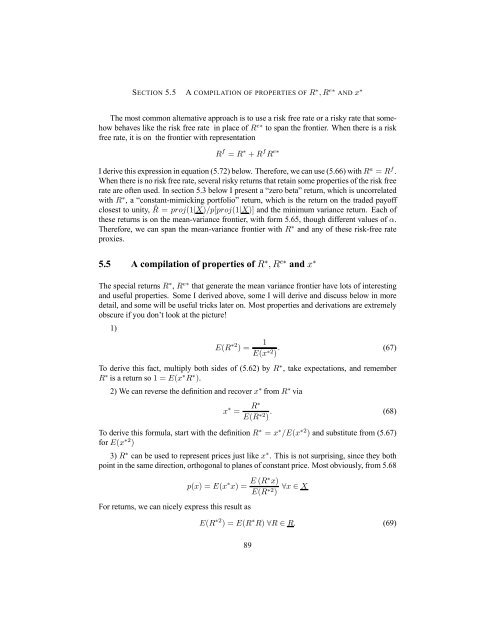Asset Pricing John H. Cochrane June 12, 2000
Asset Pricing John H. Cochrane June 12, 2000
Asset Pricing John H. Cochrane June 12, 2000
Create successful ePaper yourself
Turn your PDF publications into a flip-book with our unique Google optimized e-Paper software.
SECTION 5.5 A COMPILATION OF PROPERTIES OF R ∗ ,R e∗ AND x ∗<br />
The most common alternative approach is to use a risk free rate or a risky rate that somehow<br />
behaves like the risk free rate in place of R e∗ to span the frontier. When there is a risk<br />
free rate, it is on the frontier with representation<br />
R f = R ∗ + R f R e∗<br />
I derive this expression in equation (5.72) below. Therefore, we can use (5.66) with R a = R f .<br />
When there is no risk free rate, several risky returns that retain some properties of the risk free<br />
rate are often used. In section 5.3 below I present a “zero beta” return, which is uncorrelated<br />
with R ∗ , a “constant-mimicking portfolio” return, which is the return on the traded payoff<br />
closest to unity, ˆR = proj(1|X)/p[proj(1|X)] and the minimum variance return. Each of<br />
these returns is on the mean-variance frontier, with form 5.65, though different values of α.<br />
Therefore, we can span the mean-variance frontier with R ∗ and any of these risk-free rate<br />
proxies.<br />
5.5 A compilation of properties of R ∗ ,R e∗ and x ∗<br />
The special returns R∗ , Re∗ that generate the mean variance frontier have lots of interesting<br />
and useful properties. Some I derived above, some I will derive and discuss below in more<br />
detail, and some will be useful tricks later on. Most properties and derivations are extremely<br />
obscure if you don’t look at the picture!<br />
1)<br />
E(R ∗2 1<br />
)=<br />
E(x∗2 . (67)<br />
)<br />
To derive this fact, multiply both sides of (5.62) by R∗ , take expectations, and remember<br />
R∗ is a return so 1=E(x∗R∗ ).<br />
2) We can reverse the definition and recover x∗ from R∗ via<br />
x ∗ = R∗<br />
E(R∗2 . (68)<br />
)<br />
To derive this formula, start with the definition R∗ = x∗ /E(x∗2 ) and substitute from (5.67)<br />
for E(x∗2 )<br />
3) R∗ can be used to represent prices just like x∗ . This is not surprising, since they both<br />
point in the same direction, orthogonal to planes of constant price. Most obviously, from 5.68<br />
p(x) =E(x ∗ x)= E (R∗x) E(R∗2 ∀x ∈ X<br />
)<br />
For returns, we can nicely express this result as<br />
E(R ∗2 )=E(R ∗ R) ∀R ∈ R. (69)<br />
89
















